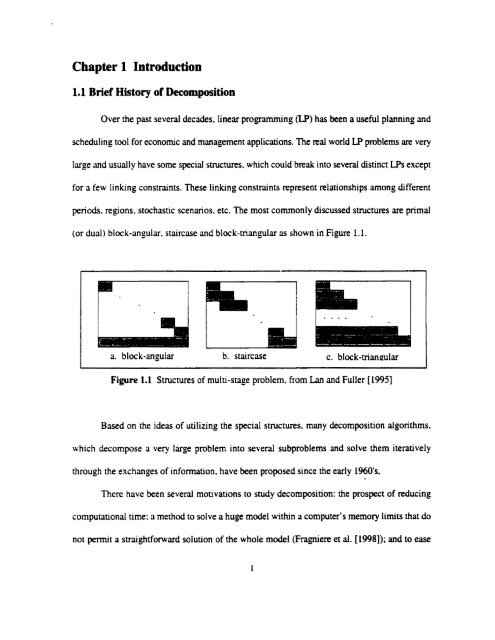- Page 1 and 2: A PARALLEL PRIMAL-DUAL DECOMPOSITIO
- Page 3 and 4: The University of Waterloo requires
- Page 5 and 6: WATPAR, and in each of the tests, t
- Page 7 and 8: To Soyoung and Katherine Eugene Par
- Page 9 and 10: 3.5 Sumary and Observations on the
- Page 11: Table 4 . I Table 5.1 Table 5.2 Tab
- Page 15 and 16: 1.2 Motivation and Objectives of th
- Page 17 and 18: 2. Pmve and dernonstrate the conver
- Page 19 and 20: Chapter 2 Literature Review This ch
- Page 21 and 22: Benders komposition Method In the B
- Page 23 and 24: in this algorithm, both subproblems
- Page 25 and 26: SIMD vs MIMD Panllel computers cm b
- Page 27 and 28: apan. In mmy LAN's, communication i
- Page 29 and 30: angular linear programs by fixing t
- Page 31 and 32: Chapter 3 Paralle1 Decomposition of
- Page 33 and 34: ound constraints. The two parts are
- Page 35 and 36: constnicted in the sarne way by res
- Page 37 and 38: 1T 17 t-IT T nlk*'T )' and &'-' = (
- Page 39 and 40: a proposal is passed back to the fi
- Page 41 and 42: END - solve ; if it is infeasible o
- Page 43 and 44: l, and Theorem 3. lb mles out the p
- Page 45 and 46: nonlinking constraints and upper bo
- Page 47 and 48: (The "only if* part) If P is infeas
- Page 49 and 50: . - Thmm 3.6 Suppose (-ri. )Jik, VI
- Page 51 and 52: the optimal value has ken reached.
- Page 53 and 54: spfl, we have have k .J< k PI -1 -
- Page 55 and 56: zi - $' 5 z+ - &J-[, and by Theorem
- Page 57 and 58: Chapter 4 Paraiiel Decomposition of
- Page 59 and 60: upper bound constraints and nonnega
- Page 61 and 62: type subproblem. The lower bound su
- Page 63 and 64:
An algorithm could be defined to ex
- Page 65 and 66:
Figure 43 9-stage decomposition pri
- Page 67 and 68:
combinations of known solutions of
- Page 69 and 70:
lower bound subproblem (parts 1 and
- Page 71 and 72:
&.',* and CI::;, are a 1 x (i - 1)
- Page 73 and 74:
from the same aggregated subproblem
- Page 75 and 76:
problems is discussed. Various prop
- Page 77 and 78:
Processor 2 Step O. Set level I cou
- Page 79 and 80:
- update and solve spi ; record opt
- Page 81 and 82:
for the optimum by exchanging the p
- Page 83 and 84:
The next result guarantees that in
- Page 85 and 86:
fonn a nondecreasing senes of lower
- Page 87 and 88:
one upper bound subproblem. The alg
- Page 89 and 90:
su, , for al1 i Note that when k= 1
- Page 91 and 92:
with proposals or cuts from other s
- Page 93 and 94:
- if t is an upper bound subproblem
- Page 95 and 96:
Proof : The Assumption guarantees t
- Page 97 and 98:
nNk-'. Proof : For i= 1.2. ... . N
- Page 99 and 100:
Chapter 5 Preliminary Implementatio
- Page 101 and 102:
5.1.1 Decomposition Phase In the de
- Page 103 and 104:
NB,~,PEI 8 # Selectmg the rows ROWS
- Page 105 and 106:
Figure 53 Example of multi-part str
- Page 107 and 108:
in each computer as discussed in Ch
- Page 109 and 110:
followiag 4 parts: scenarios 1 to 1
- Page 111 and 112:
"WSET' is the time taken on the RSI
- Page 113 and 114:
esults of the parallel decompositio
- Page 115 and 116:
Table 5.6 Performance of Parailel D
- Page 117 and 118:
We dso anaiyzed the speed-ups and e
- Page 119 and 120:
Chapter 6 Conclusions and Future Re
- Page 121 and 122:
8. tested several models for conver
- Page 123 and 124:
computational speed for some real w
- Page 125 and 126:
APPENDIX A GAMS codes of the test m
- Page 127 and 128:
hydrA 25, ...., hydrZ 1s /; paramet
- Page 129 and 130:
NwatBal(hydro,u,pericds,senarios1 .
- Page 131 and 132:
hydrEI 1100, hydrB 1200, ..... hydr
- Page 133 and 134:
VARIABLES En 'Expectation of the ut
- Page 135 and 136:
APPENDIX B The C codes of WSET We p
- Page 137 and 138:
k denoces an index of SubProblern t
- Page 139 and 140:
SPb~[kl-+; 1 else ( if (rowinfoIi]
- Page 141 and 142:
* Pack initial &ta and send '/ for(
- Page 143 and 144:
Appendiv C C codes of WATPAR We pre
- Page 145 and 146:
if (LpSub [k] ->rwnmbs [pl > HISPb-
- Page 147 and 148:
* Use advanced basis at each iterat
- Page 149 and 150:
status = CPXnewcols (env,lp, 1, &Lp
- Page 151 and 152:
TERMINATE : ..,. Free up the proble
- Page 153 and 154:
short SolveProb(C3XEWptr env, CP.XL
- Page 155 and 156:
variables and add other part's link
- Page 157 and 158:
i* Add a cut for upper level iterat
- Page 159 and 160:
C3 Proecssor 3 : Lower-Upper Bound
- Page 161 and 162:
t for(k=l; k c icer-count; k+-1 sta
- Page 163 and 164:
{ gectimeofday(&tvl, (struct cimezo
- Page 165 and 166:
i status = CPXchgcoef(env, lp, (int
- Page 167 and 168:
status = AddLamcols ( LpSub, env, I
- Page 169 and 170:
BIBLIOGRAPHY Aardal. K. And A. An.
- Page 171 and 172:
Computation". Mathematical Programm
















